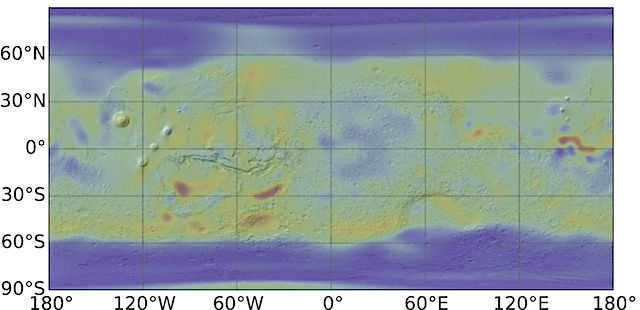 A re-analysis of data from the Neutron Spectrometer on NASA’s Mars Odyssey orbiter has nearly doubled the data’s resolution. The higher-resolution data show that small deposits of water ice lie buried at shallow depths near the martian equator in several areas.
A re-analysis of data from the Neutron Spectrometer on NASA’s Mars Odyssey orbiter has nearly doubled the data’s resolution. The higher-resolution data show that small deposits of water ice lie buried at shallow depths near the martian equator in several areas.
The results appear in a paper by Jack Wilson (Durham University, UK) and six co-authors, which was recently published in the journal Icarus.
The areas with newly found water ice deposits include the Medusae Fossae formation (MFF) and the western flanks of the Tharsis volcanoes and Elysium Mons. The western Medusae Fossae formation showed 40 wt. % water equivalent hydrogen, and the Tharsis flanks showed 10%. (Water equivalent hydrogen is used as a proxy for water, which will usually be in the form of ice at martian temperatures.)
“Our result is consistent with the lower member of the MFF containing ice rich material, which lends weight to the theory that at least part of the MFF is a polar layered-like deposit,” the scientists write.
Conversely, the data show no suggestion of buried water ice at the proposed subsurface sea in Elysium Planitia. “The Cerberus Fossae region containing plate-like features, suggested to be a buried water ice sea, was found to be exceptionally dry,” says the team.
Finally, they report that recurring slope lineae (RSLs) do not correlate with large subsurface aquifers. Instead, the team says RSLs are “the result of either small (<120 km diameter) aquifers, deliquescence of perchlorate and chlorate salts, or dry, granular flows.”
The re-analysis process, described in detail in the paper, improved the resolution of the Neutron Spectrometer’s data from 520 kilometers to 290 km. [More at link]








